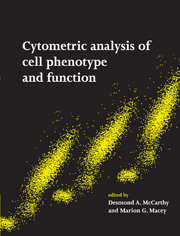Book contents
- Frontmatter
- Contents
- List of contributors
- List of abbreviations
- 1 Principles of flow cytometry
- 2 Introduction to the general principles of sample preparation
- 3 Fluorescence and fluorochromes
- 4 Quality control in flow cytometry
- 5 Data analysis in flow cytometry
- 6 Laser scanning cytometry: application to the immunophenotyping of hematological malignancies
- 7 Leukocyte immunobiology
- 8 Immunophenotypic analysis of leukocytes in disease
- 9 Analysis and isolation of minor cell populations
- 10 Cell cycle, DNA and DNA ploidy analysis
- 11 Cell viability, necrosis and apoptosis
- 12 Phagocyte biology and function
- 13 Intracellular measures of signalling pathways
- 14 Cell–cell interactions
- 15 Nucleic acids
- 16 Microbial infections
- 17 Leucocyte cell surface antigens
- 18 Recent and future developments: conclusions
- Appendix
- Index
- Plate section
16 - Microbial infections
Published online by Cambridge University Press: 06 January 2010
- Frontmatter
- Contents
- List of contributors
- List of abbreviations
- 1 Principles of flow cytometry
- 2 Introduction to the general principles of sample preparation
- 3 Fluorescence and fluorochromes
- 4 Quality control in flow cytometry
- 5 Data analysis in flow cytometry
- 6 Laser scanning cytometry: application to the immunophenotyping of hematological malignancies
- 7 Leukocyte immunobiology
- 8 Immunophenotypic analysis of leukocytes in disease
- 9 Analysis and isolation of minor cell populations
- 10 Cell cycle, DNA and DNA ploidy analysis
- 11 Cell viability, necrosis and apoptosis
- 12 Phagocyte biology and function
- 13 Intracellular measures of signalling pathways
- 14 Cell–cell interactions
- 15 Nucleic acids
- 16 Microbial infections
- 17 Leucocyte cell surface antigens
- 18 Recent and future developments: conclusions
- Appendix
- Index
- Plate section
Summary
Introduction
Flow cytometry is as yet a relatively unexploited but potentially extremely valuable method for the study of microorganisms and microbial infections. The light scattering signal produced by most viruses is beyond the detection limit of commercial flow cytometers, but bacteria and other larger microorganisms produce signals that can readily be detected. Consequently, studies involving viruses have been primarily concerned with infected cells rather than virions. Studies involving microorganisms have been directed not only at the cells, both infected and phagocytic, in which they might occur but also at the microorganisms themselves. This chapter summarises recent achievements and the potential uses of flow cytometry in the study of viruses, bacteria, yeasts and protozoa, and of the diseases caused by these microorganisms.
Viruses
Cytometric techniques have so far been applied mainly to:
studies of virus replication
the detection of virus-infected cells
the assay of antiviral compounds.
Studies of virus replication
Virus infection is initiated by attachment sites on the virion surface binding to complementary structures on the surface of susceptible host cells. The cellular receptors are normal host components that the virus has usurped solely for the purpose of gaining entry to the cell. In many instances, only certain cells of a host are susceptible to infection and the limited distribution of receptor and/or coreceptor molecules is one determinant of tissue tropisms. Therefore, the identification of cells bearing suitable receptors is one goal in understanding the molecular aspects of pathogenicity. Fluorochromelabelled virus particles have been used in at least one instance to identify cells bearing virus-specific receptors and it is likely that this technique will find wider application.
- Type
- Chapter
- Information
- Cytometric Analysis of Cell Phenotype and Function , pp. 292 - 314Publisher: Cambridge University PressPrint publication year: 2001
- 1
- Cited by

